 If there’s such a thing as the most amazing dress ever made, Carroll Baker wore it. 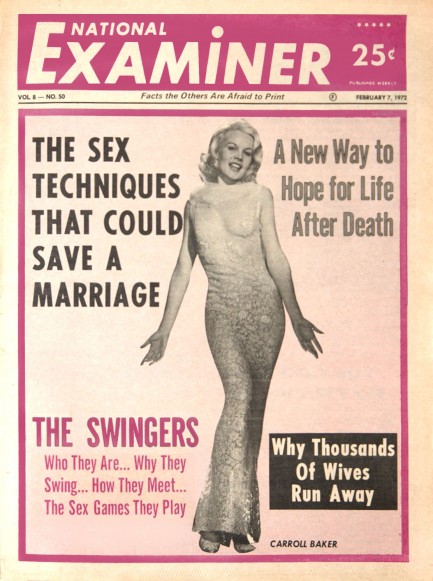
In the summer of 1964, promoting her movie The Carpetbaggers, American actress Carroll Baker attended a premiere at London’s Plaza Theatre in Piccadilly Circus wearing a $28,000.00 transparent dress from designer Pierre Balmain. She had worn it before at the U.S. premiere in June, which means Londoners had an inkling what they were going to see, but what resulted was, well, a circus. The crowd went nuts and the situation devolved into what some newspapers described as a near riot. The above National Examiner, published today in 1972, features Baker wearing what we noticed was a similar but not identical dress. We got curious where it came from, and so we went looking. Turns out in late 1964 designer Oleg Cassini, entranced by the Balmain dress, designed a similar version for Baker to wear at a promotional event in Las Vegas. The difference is in the placement of the beading—Balmain’s left a v-shaped peek-a-boo, whereas Cassini’s left a diagonal opening across the chest. You can see the difference below. Cassini had built his version of the dress in Baker’s absence using a model of identical size, but it didn’t really fit because bodies have all sorts of differences, even if their crude numerical aspects are ostensibly the same. Baker endured eighteen precarious hours in a gown that was so tight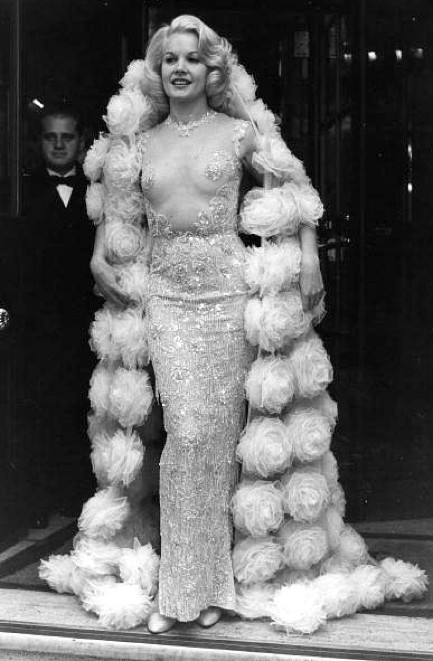 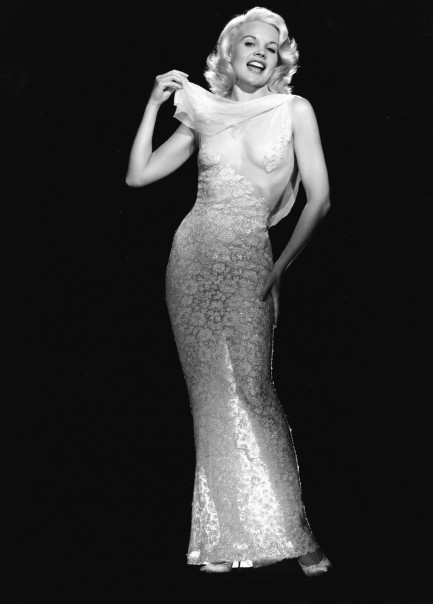 she couldn’t shake hands without it shifting to reveal parts she wanted to keep hidden. She later wore the dress—hopefully altered—at a premiere of Cheyenne Autumn, and a photo of her posing with a dozen costumed Native Americans survives today in the Associated Press archives. she couldn’t shake hands without it shifting to reveal parts she wanted to keep hidden. She later wore the dress—hopefully altered—at a premiere of Cheyenne Autumn, and a photo of her posing with a dozen costumed Native Americans survives today in the Associated Press archives. But the dress wasn’t finished quite yet. The next year immortal costumer Edith Head designed yet another variation on Balmain’s original for Baker to wear promoting the film Harlow. We don’t know where the previous two gowns went, but the Head version, one of several she put together, survived and has appeared in Hollywood fashion exhibitions as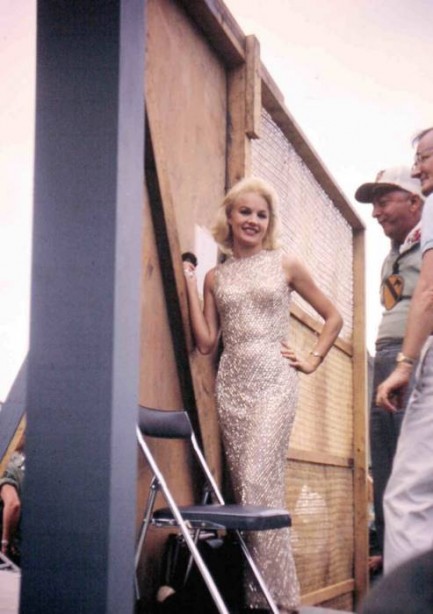 recently as 2003. Baker also wore a Balmain (or Cassini or Edith Head copy) during a 1966 troop tour in Vietnam, and the only reason a full firefight didn’t break out among the GIs the moment she unveiled herself is probably because that version had no cut-outs (right). recently as 2003. Baker also wore a Balmain (or Cassini or Edith Head copy) during a 1966 troop tour in Vietnam, and the only reason a full firefight didn’t break out among the GIs the moment she unveiled herself is probably because that version had no cut-outs (right). Extreme publicity stunts were apparently not unusual for Baker. She considered herself a good actress, but felt that she couldn’t become a star in Hollywood without promoting herself as a sex symbol. “I’ve tried just acting,” she once said, “but sex sells at the box office.” As time wore on, she went from threatening to walk off the set of Station Six—Sahara due to the director pressuring her to appear nude to playing unclothed roles in The Sweet Body of Deborah, Così dolce... così perversa, and Paranoia, as well appearing nude in Playboy and Playmen. Nothing like a shrinking bank account to totally reshape one’s morals. In 1966 AP scribe Doris Klein wrote that Baker was “almost too pretty, too much like a slim teenager to play a sexpot.” But Baker became one of the biggest sexpots in the world. Looking at the 1964 Balmain, and the three to six versions that followed, we’d say it was inevitable. 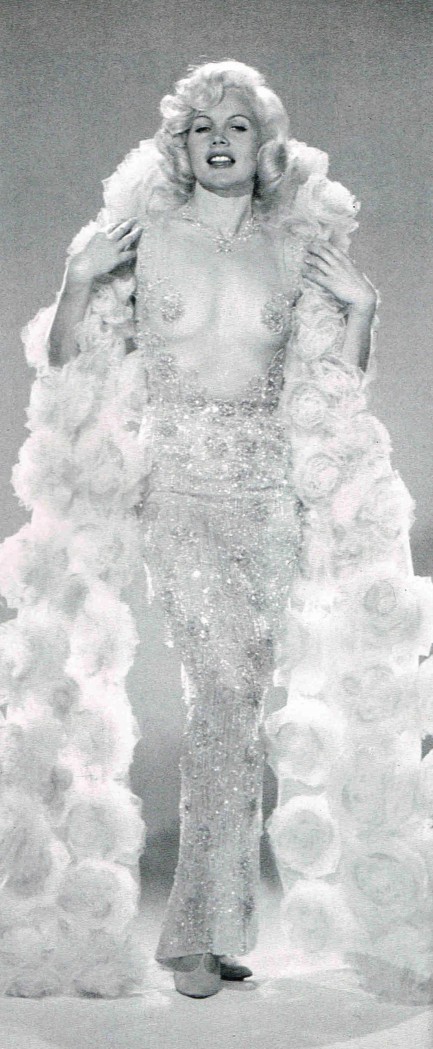 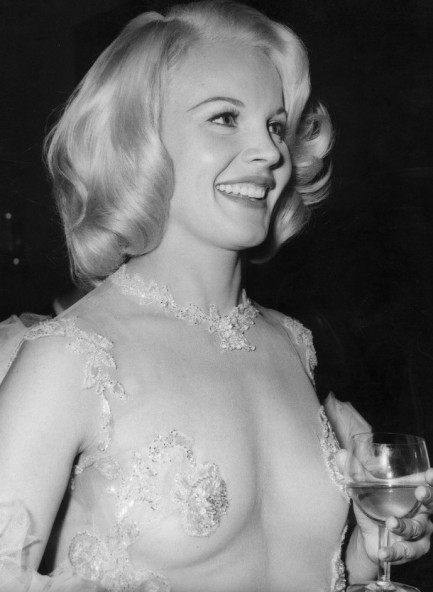
 Baker offers up a special treat. 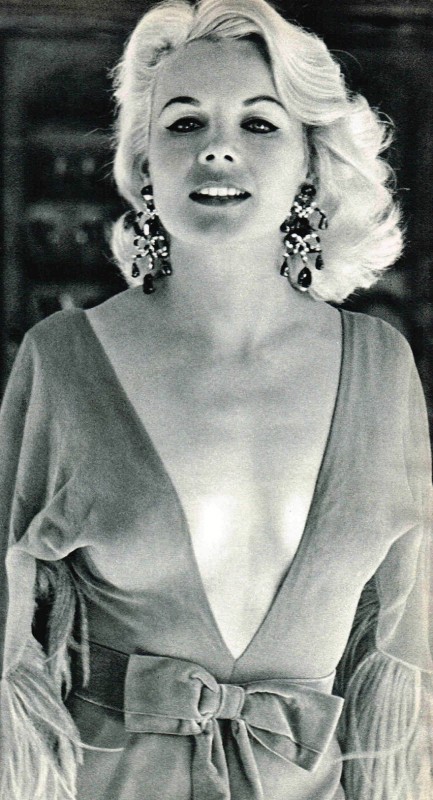 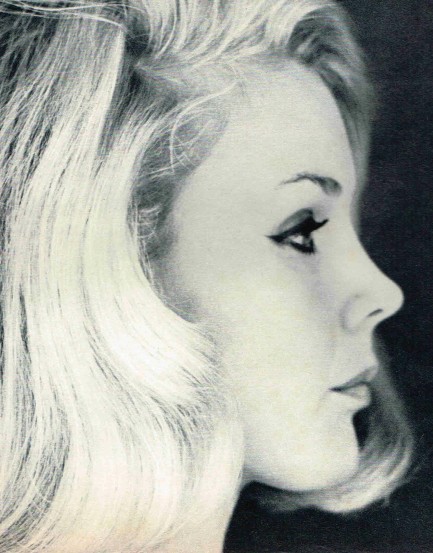
Carroll Baker was one of the few American actresses who gave European contemporaries like Florinda Bolkan, Sylva Koscina, Anita Strindberg, et al, a run for their money in terms of the provocative roles she played. Her first showbiz jobs were during the early 1950s as a dancer and weather girl, but she later appeared in movies such as Baby Doll (condemned by the Legion of Decency), Sylvia (famously recut to reduce the impact of a rape scene), Baba Yaga (based on an adult comic and chopped up by censors), Orgasmo (retitled Paranoia in the U.S.), and Andy Warhol’s Bad. Baker retired from acting in 2003. These shots both date from the mid-1960s.
|
 |

The headlines that mattered yesteryear.
2003—Hope Dies
Film legend Bob Hope dies of pneumonia two months after celebrating his 100th birthday. 1945—Churchill Given the Sack
In spite of admiring Winston Churchill as a great wartime leader, Britons elect
Clement Attlee the nation's new prime minister in a sweeping victory for the Labour Party over the Conservatives. 1952—Evita Peron Dies
Eva Duarte de Peron, aka Evita, wife of the president of the Argentine Republic, dies from cancer at age 33. Evita had brought the working classes into a position of political power never witnessed before, but was hated by the nation's powerful military class. She is lain to rest in Milan, Italy in a secret grave under a nun's name, but is eventually returned to Argentina for reburial beside her husband in 1974. 1943—Mussolini Calls It Quits
Italian dictator Benito Mussolini steps down as head of the armed forces and the government. It soon becomes clear that Il Duce did not relinquish power voluntarily, but was forced to resign after former Fascist colleagues turned against him. He is later installed by Germany as leader of the Italian Social Republic in the north of the country, but is killed by partisans in 1945.
|

|
|

It's easy. We have an uploader that makes it a snap. Use it to submit your art, text, header, and subhead. Your post can be funny, serious, or anything in between, as long as it's vintage pulp. You'll get a byline and experience the fleeting pride of free authorship. We'll edit your post for typos, but the rest is up to you. Click here to give us your best shot.

|
|



 she couldn’t shake hands without it shifting to reveal parts she wanted to keep hidden. She later wore the dress—hopefully altered—at a premiere of Cheyenne Autumn, and a photo of her posing with a dozen costumed Native Americans survives today in the Associated Press archives.
she couldn’t shake hands without it shifting to reveal parts she wanted to keep hidden. She later wore the dress—hopefully altered—at a premiere of Cheyenne Autumn, and a photo of her posing with a dozen costumed Native Americans survives today in the Associated Press archives. recently as 2003. Baker also wore a Balmain (or Cassini or Edith Head copy) during a 1966 troop tour in Vietnam, and the only reason a full firefight didn’t break out among the GIs the moment she unveiled herself is probably because that version had no cut-outs (right).
recently as 2003. Baker also wore a Balmain (or Cassini or Edith Head copy) during a 1966 troop tour in Vietnam, and the only reason a full firefight didn’t break out among the GIs the moment she unveiled herself is probably because that version had no cut-outs (right).








































































